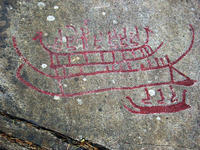You are in: Europe -> Sweden -> Rock Carvings in Tanum, and traditional search or Image Gallery will yield results of this site only
Rock Carvings in Tanum
| Site number: | 557 |
|
| Type of site: | Cultural | |
| Date: | Bronze Age | |
| Date of Inscription: | 1994 | |
| Location: | Europe, Sweden, Bohuslan | |
Up to 75 images are shown here. Click on each for more details or on Image Gallery for more images.
| Description: | Lying north of Bohuslän, the rock carvings in Tanum are a unique artistic attainment due to their cultural and chronological unity, as well as their rich and diverse motifs, holding illustrations of humans and animals, weapons and boats. They disclose the way of life as well as the viewpoints of Bronze Age Europeans; they are notable for their great numbers and terrific quality. --WHMNet paraphrase from the description at WHC Site, where additional information is available. | |
| Tanumshede (58.733° N 11.317° E) is a town in Bohuslän, Västra Götaland County in western Sweden with a population of 1,600. It is the seat of Tanum Municipality. The area around Tanumshede has been declared a World Heritage Site by UNESCO because of the high concentration of petroglyphs. The largest flat rock of Nordic Bronze Age petroglyphs in Scandinavia, the Vitlyckehäll, is located in Tanumshede. It was discovered in 1972 by Age Nilsen, who was originally intending to place an explosive charge for construction work. In total there are about 3000 Tanum petroglyphs, occurring in about 100 panels. These are concentrated in five distinct areas along a 25 km stretch, which was the coastline of a fjord during the Bronze Age, and covers an area of about 51 hectares (126 acres or 0.5 km²). Scandinavian Bronze Age and Iron Age people were sophisticated woodworkers and very competent travelers by water. (Dates for ages vary with the region; in Scandinavia, the Bronze Age is roughly 1800 to 600 BCE) Some of the glyphs depict long boats of the Hjortspring boat type carrying around a dozen passengers. Wagons or carts are also depicted. One glyph depicts a hunter with a bow, and others depict hunting scenes. Some of the stone pictures show people performing agrarian tasks. There is a human at a plough drawn by two oxen, holding what might be a branch or an ox-goading crop made of a number of strips of hide. The rock carvings are endangered by erosion due to pollution. To the dismay of some archaeologists, they have been painted red to make them more visible for tourists. --Wikipedia. Text is available under the Creative Commons Attribution-ShareAlike License. | ||
| Source: | http://whc.unesco.org/en/list/557 | |
| Reference: | 1. UNESCO World Heritage Center, Site Page. | |




































